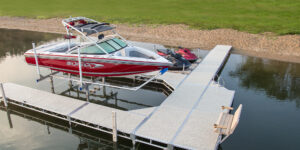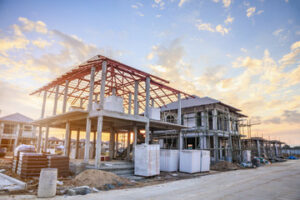Dock Lifts Charleston SC is a convenient way to keep your watercraft out of the water when you’re not using it. This helps prevent marine growth that can cling to the hull and propellers and protect it from damage caused by severe weather conditions.
Choosing the right lift is dependent on the location of your dock. Rougher water areas typically require a lift with more strength and bracing.

A boat lift prevents the corrosive build-up of layers of moisture that eat away at your vessel’s hull, dramatically reducing its performance, value, and lifespan. It also eliminates the need to continually tie your boat to a dock, which can cause deterioration of the dock, boat lines, and chains.
Your boat is costly, and you want it to look nice and remain in good condition. Keeping your ship in water causes corrosion, which leads to constant cleaning, washing, and repainting, as well as expensive hull repairs. A boat lift will protect your watercraft and ensure its beauty and longevity.
Your boat must be secured to your dock or shore when you’re not enjoying the water. This is a hassle and can create serious damage. Tieing your boat to a dock can lead to its keel and propeller being scratched by the dock’s pilings and from scraping against it. If you’re in a body of water with rough weather and frequent tide changes, your boat can easily be pushed against the dock, rocked by waves, and smashed into winter ice floes and flood debris. A boat lift keeps your vessel safely above the water line, preventing these damages and saving you time and money.
Regular inspections and maintenance are crucial for your boat lift’s proper functioning. Inspect the cables for fraying, rust, or kinking, and make sure they are properly positioned within the sheave of your lift. Also, inspect the frame and rack for jams and be aware of how the motor turns when relieving pressure by flipping your switch. Always follow manufacturer instructions when operating your boat lift to avoid damaging it.
A standard-built boat lift is sufficient if you’re in calm water. However, it’s still important to maintain your lift. Regular cleaning with a commercial cleaner and a fresh coat of marine-grade paint can help extend its lifespan. Additionally, thoroughly cleaning and lubricating the cable sheaves and pulleys will reduce friction-induced wear and tear and keep them running smoothly.
As boats age, the hull can begin to absorb water. This moisture can lead to organism growth, corrosion, and deterioration. By keeping the boat you have hoisted above the water line when not in use, a lift system prevents water absorption and protects against the erosion of your vessel’s bottom. A clean, dry bottom is easier to maintain and improves your boat’s performance. It also saves fuel, reduces gas mileage, and eliminates recurring costs associated with painting the underside of your boat.
Another problem caused by leaving your vessel in the water is fluctuating water levels due to rain, seasonal changes, and even the weather. This fluctuation can damage your ship and affect its stability, making it difficult to board or disembark from the boat. A floating boat lift keeps your vessel out of the water and away from fluctuating conditions, preventing this damage.
A boat lift consists of a base anchoring to your dock and a cradle system holding the vessel. It may also have a support tank that lifts or lowers the craft. Some models have a wireless remote control to make it easy to operate your lift from several hundred feet away. Some models also have floodlights to help you easily maneuver your boat in the dark.
The lifts are available in a variety of shapes and sizes. Some are free-standing and can be manually operated, solar-powered or electric. They can also include add-ons like canopies, power curtains, and docking guides. Most are made of aluminum, which is durable and easy to protect from saltwater corrosion. Some have a winch or cable system to lift and lower the boat, while others have a hydraulic cylinder.
When using a boat lift, follow the manufacturer’s weight limit recommendations. Exceeding the recommended capacity can damage the lift, causing it to break or not work properly. Using a lift with excessive weight can also be dangerous and possibly detrimental to your vessel or other nearby objects.
Keeping your boat above the waterline with a lift protects it from scrapes and scratches when entering or exiting the water. It also keeps marine growth from clinging to the hull and propellers, which can cause performance issues and fuel inefficiency. Boat lifts are also easier to maneuver than tying the vessel at a dock and can reduce the work required to move the boat for launching or parking it.
When choosing a boat lift, choosing one designed for your specific location and dock configuration is important. Some areas have consistent water depths that need to be considered, while others experience dramatic changes in tidal levels throughout the year. If you live in a rough water location, look for a stronger lift in its arms, mechanisms, bolts, and bushings. This additional reinforcement will help prevent damage to the lift, dock, and boat during harsh weather conditions.
It would be best to consider how often you’ll be using your lift and the size of your boat to find a lift that meets your needs. Look for a lift with wedge locks that make it easy to adjust cable length, level the cradle, and adjust the pitch of your boat. Also, choose a lift that uses maintenance-free self-lubricating cable bearings that eliminate the need for regular lubrication.
Before you begin using your lift, make sure to clean it thoroughly. Rinsing the lift cables in fresh water after every use helps keep salt from damaging them and extends their lifespan. It’s also a good idea to rinse the cradle and top beams occasionally to remove dirt and debris that may have been collected on them.
When using your lift, follow the manufacturer’s instructions for operation and safety. Always check your surroundings when backing out of the lift to avoid hitting other boats, docks, or people. When parking your ship, have a second person onboard to distribute the weight and help you maneuver it into position. Be patient when backing out, and never rush, as this can lead to an accident that damages the lift or boat.
When you install a private boat lift at your home dock, you can keep your vessel safe from theft. Personal watercraft are highly desirable targets for thieves in a marina or remote port. A boat lift makes it more challenging for bad actors to steal your boat or watercraft because they must work harder to free it from the cradle. This increased effort can deter criminals from attempting to steal your boat, which is good for you and the rest of your neighbors.
A boat lift elevates your vessel off the waterline, protecting you from waves, marine growth, and dirt/algae build-up. A quality lift can also help extend the life of your boat and reduce the need for costly repairs. Additionally, a boat lift can increase the resale value of your property. This added feature is attractive to potential buyers because it protects their investment from damage while they’re not using it.
There are several different types of boat lifts, but they all operate similarly. When a watercraft is parked on the lift, it rests on bunk boards attached to a cradle that can be raised and lowered with a button. Before you use your lift, it’s important to ensure the cradle is properly positioned on the bunk boards. If the cradle isn’t correctly set, it can cause your boat to sink or sway. It would be best to empty your ballast before attempting to drive onto the lift. A full ballast can add more weight than the lift was designed to support, which can damage the lift or cause it to wear out prematurely.
It would also be best to regularly lubricate the cradle’s cables, pulleys, and bearings. This will help slow down the speed at which the parts wear, and it can help prevent any costly damages. While lubricating the system, inspecting it for loose bolts and nuts that could interfere with the lift’s performance is also a good idea. Sometimes, you may need to replace certain parts of your boat lift to keep it in optimal condition.

